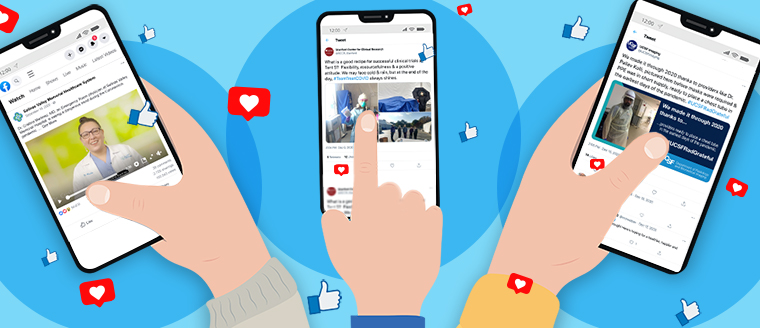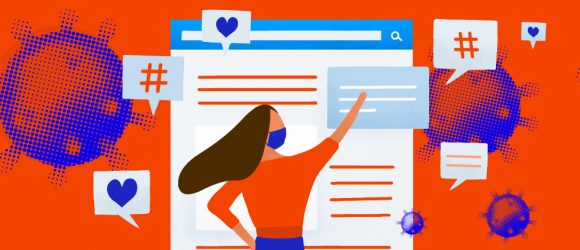Social Content Marketing and Healthcare: Using Social Media to Show Your “Human Side”

Amid all of the chaos and uncertainty in this world, many of us are craving connection and accurate information. Social media is a great way for marketers to provide both. As social content marketers, we are always looking for ways to make healthcare organizations’ social presences feel more personal, while still being professional and informative. This helps your organization boost social media engagement with your target audience, establish greater authenticity, re-engage existing followers and involve employees or team members in the process.
If you’re looking for ways to show your “human side,” we have a few ideas and suggestions paired with recent examples of healthcare organizations who have done a great job doing so during the COVID-19 pandemic.
1. Go behind the scenes
Lifting the curtain on your organization’s day-to-day operations helps build a stronger connection with followers. During COVID-19, the teams at the Stanford Center for Clinical Research (client) have been heavily involved in clinical trials for COVID-19 treatments. Thanks to user-generated content (UGC) from clinical research project managers, SCCR has been able to provide a face to those working so hard behind the scenes.
2. Try a social media takeover
Social media takeovers can help you connect with target audiences who would otherwise have been difficult to reach. This past summer, the Stanford University Department of Psychiatry and Behavioral Sciences (client) wanted to engage with prospective students who were unable to visit campus due to COVID-19. They hosted a resident Twitter takeover (#StanfordPsyResidents) as part of a larger initiative with other departments in the School of Medicine (#SUResidentTakeover) to share their experiences with prospective residents.
According to Sprout Social, “A social media takeover is essentially a form of influencer marketing. It’s kind of like dipping your toes into the pool but not completely committing to it.” (They also provide some good basics for running a takeover from start to finish.)
3. Use user-generated content (UGC) to build camaraderie and celebrate accomplishments
Celebrating accomplishments or milestones doesn’t always have to feel corporate. Why not use your social media platforms and get your team involved? At the end of a challenging year, UCSF Radiology (client) decided to put together a social media gratitude campaign (#UCSFRadGrateful). The campaign allowed faculty, staff and trainees the opportunity to share images and captions to give kudos and appreciation to colleagues. Submissions told stories of camaraderie, light-hearted fun and problem-solving. Overall, this campaign provided heartwarming content while helping to put a positive spin on working in healthcare during the pandemic.
4. Create videos featuring your own experts
As you scroll through your social media feeds, you might notice that video grabs your attention. According to Buffer, “Facebook video receives, on average, 135 percent more organic reach than a Facebook photo.” During the COVID-19 pandemic, we’ve seen healthcare organizations of all sizes use video to create compelling, informative content. SVMHS, a Monterey County, California-based healthcare system, does a great job of using video (both produced and live streamed) to convey important messages. They also do a great job using their clinicians and experts to tell the story, putting faces to their messages to add authenticity, relatability and credibility.
5. Ask your employees to share their stories
Speaking of authenticity, relatability and credibility, there is a lot of information (and misinformation) circulating about the COVID-19 vaccine. According to the Binary Foundation, global search volume on Google for vaccine information reached an all-time high in December, with spikes in searches related to vaccine reactions, how many people have had the vaccine and side effects. People are looking for answers, and it’s important that they have accurate information. And since healthcare workers were some of the first to receive the vaccination, they are good sources of information. Einstein Healthcare Network, a Greater Philadelphia-based healthcare network asked some of their clinicians to share their vaccine journey on social media. Social media videos (such as the one shown below) can be short and simple and don’t require a lot of budget and production costs.
Some of the examples provided were our work, while others were examples that we found that stood out for the way they connected with their audience. Healthcare organizations, remember that social media does not need to be boring or matter-of-fact… especially right now. Trying out some of these ideas can help you incorporate a mixture of factual, inspirational and engaging content in your social media cadence to help your audience feel more connected to the brand and better informed. You’ll likely see your engagements, impressions and reach increase as well.







